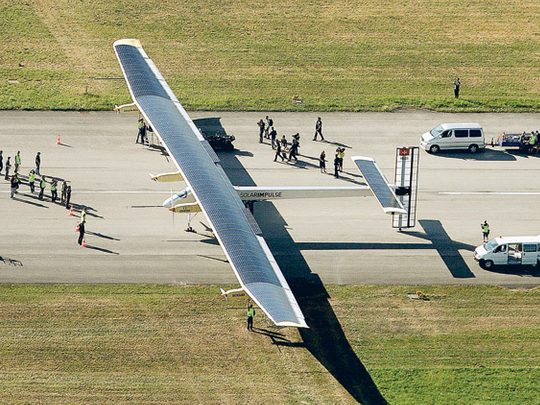
Payerne, Switzerland: An experimental solar-powered plane completed its first 24-hour test flight successfully yesterday, proving that the aircraft can collect enough energy from the sun during the day to stay aloft all night.
The test brings the Swiss-led project one step closer to its goal of circling the globe using only energy from the sun.
Pilot Andre Borschberg eased the Solar Impulse out of the clear blue morning sky onto the runway at Payerne airfield about 50km southwest of the Swiss capital Bern at exactly 9am.
Helpers rushed to stabilize the pioneering plane as it touched down, ensuring that its massive 63-metre wingspan didn't scrape the ground and topple the craft.
"We achieved more than we wanted. Everybody is extremely happy," Borschberg said after landing.
Previous flights included a brief "flea hop" and a longer airborne test earlier this year, but this week's attempt was described as a "milestone" by the team and comes after seven years of planning.
The team says it has now demonstrated that the single-seat plane can theoretically stay in the air indefinitely, recharging its depleted batteries using 12,000 solar cells and nothing but the rays of the sun during the day.
But while the team says this proves that emissions-free air travel is possible, it doesn't see solar technology replacing conventional jet propulsion any time soon.
Instead, the project's overarching purpose is to test and promote new energy-efficient technologies.
Project co-founder Bertrand Piccard, himself a record-breaking balloonist, said many people had been sceptical that renewable energy could ever be used to take a man into the air and keep him there.
"There is a before and after in terms of what people have to believe and understand about renewable energies," Piccard said, adding that the flight was proof new technologies can help break society's dependence on fossil fuels.
Efficient successor
The team will now start to build a second solar plane that will be more efficient and have a larger cockpit to allow for longer flights. That plane should be ready for international flights by 2013, said Borschberg.
The round-the-world flight will eventually be made with five stops along the way.
Borschberg took off from Payerne airfield shortly before 7am Wednesday, allowing the plane to soak up the sunshine as he flew gentle loops over the Jura mountains west of the Swiss Alps.
The custom-built aircraft with its thin fuselage and the wingspan of a Boeing 777 passenger jet managed to climb to 28,000 feet and reached top speeds of over 120 kilomtres per hour.












